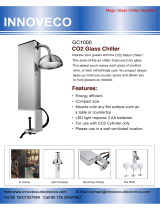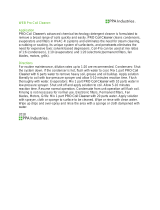
18 DKRCI.PA.000.C1.22 / 520H2564 © Danfoss A/S (RA Marketing/MWA), 12 - 2007
Application Handbook Automatic Controls for Industrial Refrigeration Systems
3. Condenser Controls
3.1
Air Cooled Condensers
In areas where there are large variations in
ambient air temperatures and/or load conditions,
it is necessary to control the condensing
pressure to avoid it from falling too low. Too
low condensing pressures results in there being
insufficient pressure differential across the
expansion device and the evaporator is supplied
with insufficient refrigerant. It means that
condenser capacity control is mainly used in the
temperate climate zones and to a lesser degree in
subtropical and tropical zones.
The basic idea of control is to control the
condenser capacity when the ambient
temperature is low, so that the condensing
pressure is maintained above the minimum
acceptable level.
This condensing capacity control is achieved
either by regulating the flow of circulating air or
water through the condenser, or by reducing the
effective heat exchange surface area.
Different solutions can be designed for different
types of condensers:
3.1 Air cooled condensers
3.2 Evaporative condensers
3.3 Water cooled condensers
An air-cooled condenser consists of tubes mounted
within a fin block. The condenser can be horizontal,
vertical or V-shaped. The ambient air is drawn across
the heat exchanger surface with axial or centrifugal
fans.
Air-cooled condensers are used on industrial
refrigeration systems where the relative air humidity
is high. Controlling the condensing pressure for air-
cooled condensers can be achieved in the following
ways:
3.1.1 - Step Control of Air Cooled Condensers
The first method was using the required number
of pressure controls in the form the Danfoss RT-5
and adjusting them to different set cut-in and
cut-out pressures.
The second method of controlling the fans was
by using a neutral zone pressure controller in the
form of the Danfoss type RT-L. Initially it was used
together with a step controller with the required
number of contacts for the number of fans.
3.1.2 - Fan speed control of air cooled condensers
This method of condenser fan control is mainly
used whenever a reduction in noise level is
desired due to environmental concerns.
For this type of installation Danfoss frequency
converter AKD can be used.
3.1.3 - Area control of air cooled condensers
For area or capacity control of air cooled
condensers a receiver is required. This receiver
must have sufficient volume to be able to
accommodate the variations in the amount of
refrigerant in the condenser.
Two ways this condenser area control can be
done:
1. Main valve ICS or PM combined with the
constant pressure pilot CVP(HP) mounted in
the hot gas line on the inlet side to the
condenser and ICV combined with a
differential pressure pilot CVPP(HP) mounted
in the pipe between the hot gas line and the
receiver. In the pipe between the condenser
and the receiver a check valve NRVA is
mounted to prevent liquid migration from the
receiver to the condenser.
However this system reacted too fast and timers
were used for delaying the cut-in and cut-out of
the fans.
The Third method is today’s step controller the
Danfoss EKC-331.
2. Main valve ICS combined with the constant
pressure pilot CVP(HP) mounted in the pipe
between the condenser and the receiver and
a ICS combined with a differential pressure
pilot CVPP(HP) mounted in the pipe between
the hot gas line and the receiver. This method
is mainly used in commercial refrigeration.
























